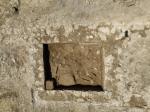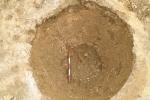Summary (English)
The 2023 excavations at the villa of Aiano concentrated on the northern part of the site, in particular the storage area excavated from 2019 onwards. Following a general clearing of the area, the south and west edges of room β were exposed. The latter is a large rectangular room (c. 30 × 9 m) with six central pillars. A row of fourteen dolia defossa was found along the south wall. In addition, two rectangular vats were uncovered in area 14300 along the west wall. East of room β, another room was identified (ε), circa 4.5 m wide. The shape and dimensions of this room could be identical to those of room α, thus conferring a symmetry to this zone. The discovery of a third pillar south of room β suggests the presence of a porticoed structure, parallel with room β, which continued to the west with a wing aligned north-south, abutting room U. These two porticoes probably bordered a large courtyard area, whose floor surface remains unknown at present.
Area 14300 corresponds with the western part of room β. The area, partially excavated in 2022, was extended to the north to include two rectangular vats discovered during the general clearing. The excavations focused on the dolia found in the southern part of the sector and the south vat. Although the excavation is ongoing, it is already possible to suggest that when the vat went out of use, it was filled with building rubble probably in phase with the filling of the dolia.
Area 14400, is situated inside room β, delimited to the west by area 14200 and the east by area 14100. After cleaning, four pits for housing dolia appeared. The excavation of the latter confirmed the following sequence of activities, already identified in previous years: 1) cut of pits for housing the dolia and positioning of the dolia; 2) the space between the dolium and the pit walls are filled with soil and opus signinum, thus making the container stable and providing thermal insulation; 3) when the villa at Aiano loses its residential function, some of the dolia seem to have been removed while most were left in situ, the latter were filled with soil and building rubble. Some of the dolia rims were removed to create a level surface for laying the floor make-up.
To conclude, the position of the north-eastern zone of the villa, its plan and the quantity of dolia defossa found, in addition to the two rectangular vats (_lacus_), suggest the presence of an imposing cella vinaria. The archeometric analyses undertaken on samples from the dolia fills should offer further insight.
- Anthony Peeters - Université catholique de Louvain
Director
- Marco Cavalieri, Université catholique de Louvain
Team
- Anthony Peeters - Université catholique de Louvain
- Gessica Bonini - Université catholique de Louvain
- Valentina Limina - Université catholique de Louvain
- Benedetta Corsini, Università degli Studi di Siena
- Hugo Lambert, Aymeric Piteüs New, Alexandre Simon - UCLouvain
- Alessandro Novellini - collaboratore esterno UCLouvain
Research Body
- Université catholique de Louvain (UCLouvain)
Funding Body
- FNRS - Crédit de recherche (CDR)
- FNRS - Equipement (EQP)
- FW-B






![Download [PDF]](/excavation/skins/fasti/images/results/download_sml.png)


